GANs comparison without cherry-picking
Implementations of some theoretical generative adversarial nets: DCGAN, EBGAN, LSGAN, WGAN, WGAN-GP, BEGAN, and DRAGAN.
I implemented the structure of model equal to the structure in paper and compared it on the CelebA dataset without cherry-picking.
Table of Contents
Features
- Model architectures are same as the architectures proposed in each paper
- Each model was not much tuned, so the results can be improved
- Well-structured (was my goal at the start, but I don't know whether it succeed!)
- TensorFlow queue runner is used for input pipeline
- Single trainer (and single evaluator) - multi model structure
- Logs in training and configuration are recorded on the TensorBoard
Models
- DCGAN
- LSGAN
- WGAN
- WGAN-GP
- EBGAN
- BEGAN
- DRAGAN
The family of conditional GANs are excluded (CGAN, acGAN, SGAN, and so on).
Dataset
CelebA
http://mmlab.ie.cuhk.edu.hk/projects/CelebA.html
- All experiments were performed on 64x64 CelebA dataset
- The dataset has 202599 images
- 1 epoch consists of about 1.58k iterations for batch size 128
Results
- I implemented the same as the proposed model in each paper, but ignored some details (or the paper did not describe details of model)
- Granted, a little details make great differences in the results due to the very unstable GAN training
- So if you had a better results, let me know the settings 🙂
- Default batch_size=128 and z_dim=100 (from DCGAN)
DCGAN
Radford, Alec, Luke Metz, and Soumith Chintala. "Unsupervised representation learning with deep convolutional generative adversarial networks." arXiv preprint arXiv:1511.06434 (2015).
- Relatively simple networks
- Learning rate for discriminator (D_lr) is 2e-4 and learning rate for generator (G_lr) is 2e-4 (proposed in the paper) and 1e-3
| G_lr=2e-4 | G_lr=1e-3 |
|---|---|
| 50k | 30k |
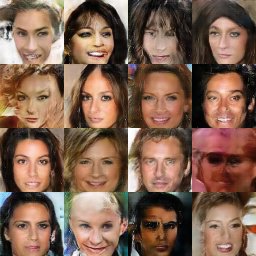 |
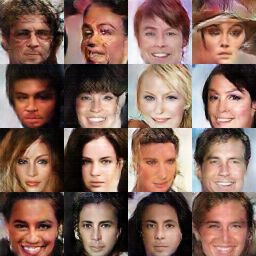 |
Second row (50k, 30k) indicates each training iteration.
Higher learning rate (1e-3) for generator made better results. In this case, however, the generator has been collapsed sometimes due to its large learning rate. Lowering both learning rate may bring stability like https://ajolicoeur.wordpress.com/cats/ in which suggested D_lr=5e-5 and G_lr=2e-4.
EBGAN
Zhao, Junbo, Michael Mathieu, and Yann LeCun. "Energy-based generative adversarial network." arXiv preprint arXiv:1609.03126 (2016).
- I like energy concept, so this paper is very interesting for me :)
- But there is criticism: Are Energy-Based GANs any more energy-based than normal GANs?
- Anyway, the energy concept and autoencoder based loss function are impressive, and the results are also fine
- But I have a question for Pulling-away Term (PT), which prevents mode-collapse theoretically. This is the same idea as minibatch discrimination (T. Salimans et al).
| pt weight = 0.1 | No pt loss |
|---|---|
| 30k | 30k |
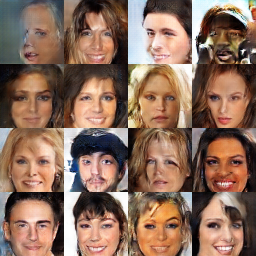 |
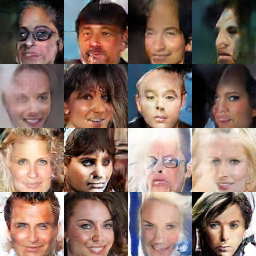 |
The model using PT generates slightly better sample visually. However, it is not clear from this results whether PT prevents mode-collapse. Furthermore, I could not distinguish what setting is better from repeated experiments.
| pt weight = 0.1 | No pt loss |
|---|---|
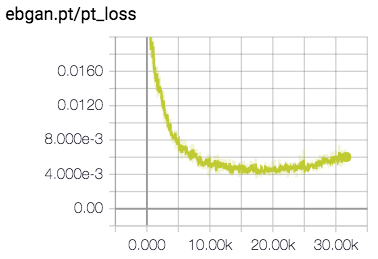 |
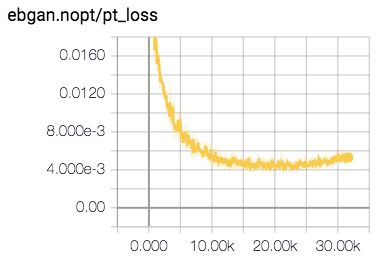 |
pt_loss decreases a little faster in the left which used pt_weight=0.1 but there is no big difference and even at the end the right which used no pt_loss showed a lower pt_loss. So I wonder: is the PT loss really working for preventing mode-collapse as described in the paper?
LSGAN
Mao, Xudong, et al. "Least squares generative adversarial networks." arXiv preprint ArXiv:1611.04076 (2016).
- Unusually, LSGAN used large latent space dimension (z_dim=1024)
- But in my experiment, z_dim=100 makes better results than z_dim=1024 which is originally used in paper
| z_dim=100 | z_dim=1024 |
|---|---|
| 30k | 30k |
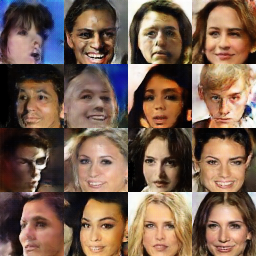 |
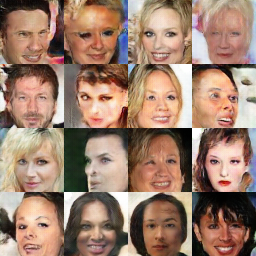 |
WGAN
Arjovsky, Martin, Soumith Chintala, and Léon Bottou. "Wasserstein gan." arXiv preprint arXiv:1701.07875 (2017).
- The samples from WGAN are not that impressive - compared to the very impressive theory
- Also no specific network structure proposed, so DCGAN architecture was used for experiments
| 30k | W distance |
|---|---|
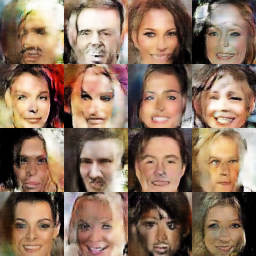 |
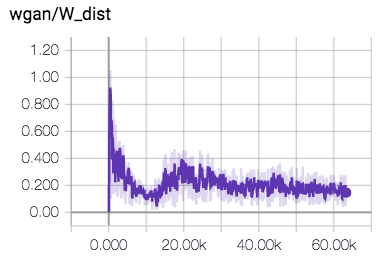 |
WGAN-GP
Gulrajani, Ishaan, et al. "Improved training of wasserstein gans." arXiv preprint arXiv:1704.00028 (2017).
- I tried two network architectures, which are DCGAN architecture and ResNet architecture in appendix C
- ResNet has more complicated architecture and better performance than DCGAN architecture
- The interesting thing is that the visual quality of samples improves very quickly (ResNet WGAN-GP has best samples on 7k iterations) and it gets worse when continue training
- According to DRAGAN, constraints of WGAN are too restrictive to learn good generator
| DCGAN architecture | ResNet architecture |
|---|---|
| 30k | 7k, batch size = 64 |
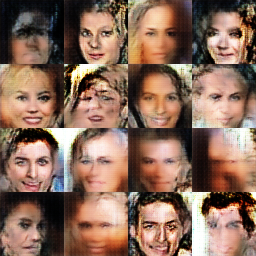 |
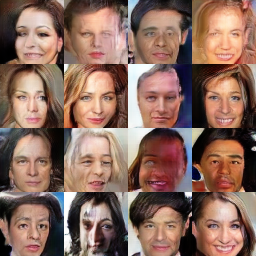 |
Face collapse phenomenon
WGAN-GP was collapsed more than other models when the iteration increases.
DCGAN architecture
| 10k | 20k | 30k |
|---|---|---|
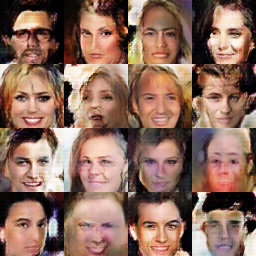 |
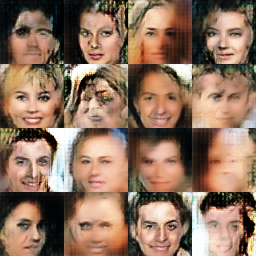 |
 |
ResNet architecture
ResNet architecture showed the best visual quality sample in the very early stage, 7k iteration in my criteria. This maybe due to the residual architecture.
batch_size=64.
| 5k | 7k | 10k | 15k |
|---|---|---|---|
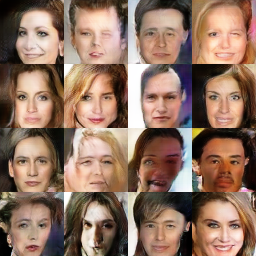 |
 |
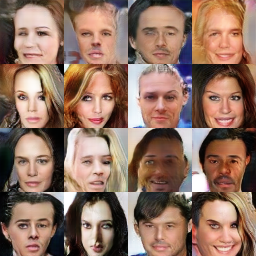 |
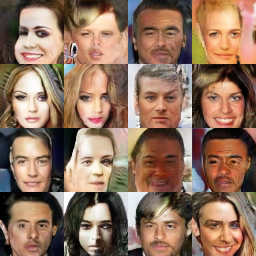 |
| 20k | 25k | 30k | 40k |
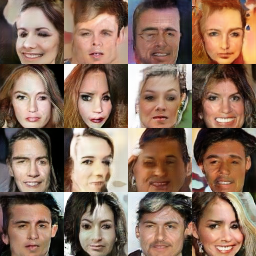 |
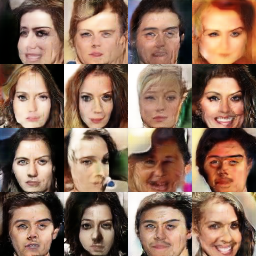 |
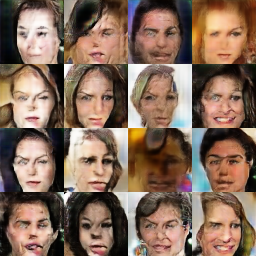 |
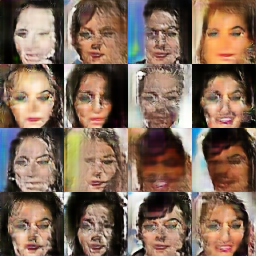 |
Regardless of the face collapse phenomenon, the Wasserstein distance decreased steadily. It should come from that the critic (discriminator) network failed to find the supremum and K-Lipschitz function.
| DCGAN architecture | ResNet architecture |
|---|---|
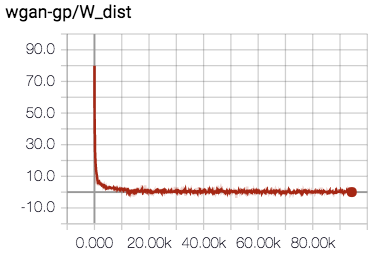 |
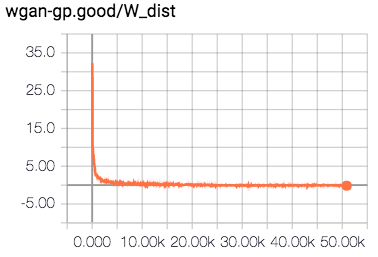 |
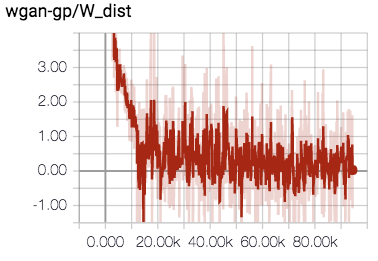 |
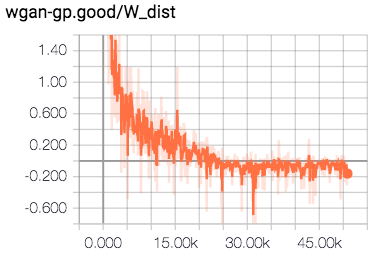 |
The plots in the last row of the table are just expanded version of the plots in the second row.
It is interesting that W_dist < 0 at the end of the training. This indicates that E[fake] > E[real] and, in the point of original GAN view, it means the generator dominates the discriminator.
BEGAN
Berthelot, David, Tom Schumm, and Luke Metz. "Began: Boundary equilibrium generative adversarial networks." arXiv preprint arXiv:1703.10717 (2017).
- The best model that generates samples with the best visual quality as far as I know
- It also showed the best performance in this project
- Even though optional improvements was not implemented (section 3.5.1 in the paper)
- However, the samples generated by BEGAN give a slightly different feel from other models - it seems like disappearing details.
- So I just wonder what the results are for different datasets
batch_size=16, z_dim=64, gamma=0.5.
| 30k | 50k | 75k |
|---|---|---|
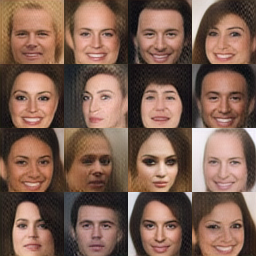 |
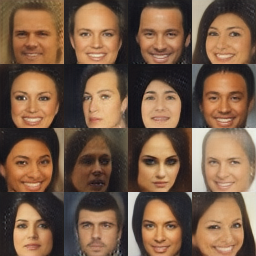 |
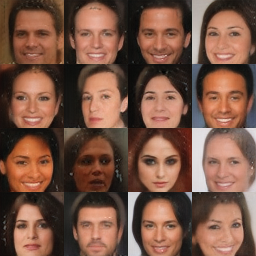 |
| Convergence measure M |
|---|
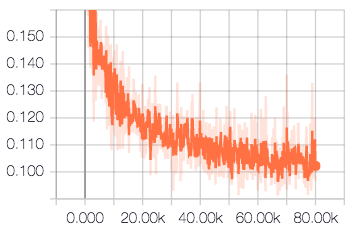 |
DRAGAN
Kodali, Naveen, et al. "How to Train Your DRAGAN." arXiv preprint arXiv:1705.07215 (2017).
- Different with other papers, DRAGAN was motivated from the game theory for improving performance of GAN
- This approach through the game theory is highly unique and interesting
- Also it shows good results
- The algorithm looks similar to WGAN-GP
| DCGAN architecture |
|---|
| 30k |
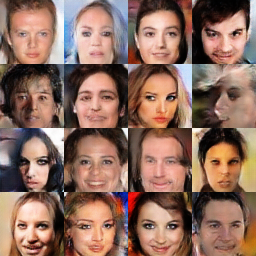 |
Conclusion
- BEGAN showed the best performance
- It is partly due to a very careful networks structure and parameter settings
- I wonder whether it will works the best for other dataset
- The results from WGAN and WGAN-GP were not as impressive as its beautiful theory
- It is difficult to rank models except BEGAN due to the lack of quantitative measure. The visual quality of generated samples from each model seemed similar.
- Conversely speaking, there have been a lot of GANs since DCGAN, but there is not a lot of significant improvement in visual quality (except for BEGAN) 🤔🤔
Usage
Download CelebA dataset:
$ python download.py celeba
Convert images to tfrecords format. Options for converting are hard-coded, so ensure to modify it before run convert.py.
$ python convert.py
Train. If you want to change the settings of each model, you must also modify code directly.
$ python train.py --help
usage: train.py [-h] [--num_epochs NUM_EPOCHS] [--batch_size BATCH_SIZE]
[--num_threads NUM_THREADS] --model MODEL [--name NAME]
[--renew]
optional arguments:
-h, --help show this help message and exit
--num_epochs NUM_EPOCHS
default: 20
--batch_size BATCH_SIZE
default: 128
--num_threads NUM_THREADS
# of data read threads (default: 4)
--model MODEL DCGAN / LSGAN / WGAN / WGAN-GP / EBGAN / BEGAN /
DRAGAN
--name NAME default: name=model
--renew train model from scratch - clean saved checkpoints and
summaries
Monitor through TensorBoard:
$ tensorboard --logdir=summary/name
Evaluate (generate fake samples):
$ python eval.py --help
usage: eval.py [-h] --model MODEL [--name NAME]
optional arguments:
-h, --help show this help message and exit
--model MODEL DCGAN / LSGAN / WGAN / WGAN-GP / EBGAN / BEGAN / DRAGAN
--name NAME default: name=model
Requirements
- python 2.7
- tensorflow 1.2
- tqdm
- (optional) pynvml - for automatic gpu selection